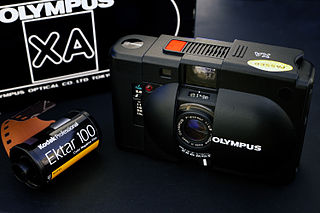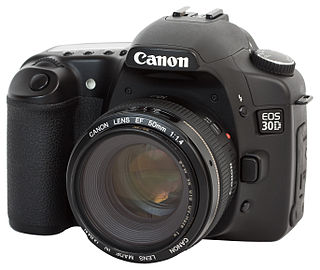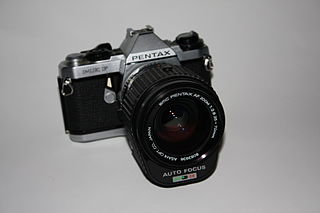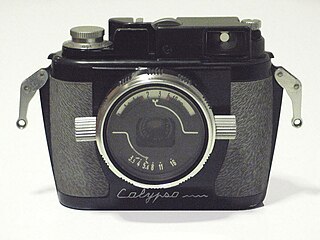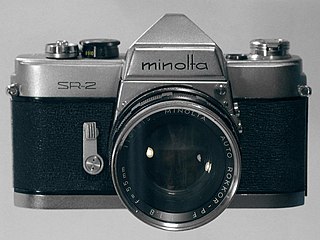
The Ricoh 500 was one of the early relatively inexpensive 35 mm rangefinder cameras to enter the U.S. market in 1957. [1] It had an unusually large (for that time) f/2.8 lens, and shutter speeds from 1 second to 1/500 second. Film was advanced by a rapid-throw "trigger" mechanism on the bottom, and focus was controlled by two buttons, at the 3 o'clock and 9 o'clock positions that permitted very rapid shifts of focus when needed for basketball and other such sporting events. Flash could be fired from a "hot shoe" on the top and from a regular socket connection.

A rangefinder camera is a camera fitted with a rangefinder, typically a split-image rangefinder: a range-finding focusing mechanism allowing the photographer to measure the subject distance and take photographs that are in sharp focus. Most varieties of rangefinder show two images of the same subject, one of which moves when a calibrated wheel is turned; when the two images coincide and fuse into one, the distance can be read off the wheel. Older, non-coupled rangefinder cameras display the focusing distance and require the photographer to transfer the value to the lens focus ring; cameras without built-in rangefinders could have an external rangefinder fitted into the accessory shoe. Earlier cameras of this type had separate viewfinder and rangefinder windows; later the rangefinder was incorporated into the viewfinder. More modern designs have rangefinders coupled to the focusing mechanism, so that the lens is focused correctly when the rangefinder images fuse; compare with the focusing screen in non-autofocus SLRs.
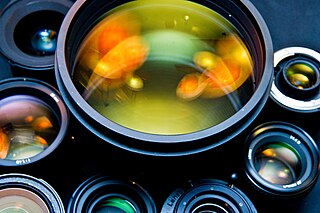
A camera lens is an optical lens or assembly of lenses used in conjunction with a camera body and mechanism to make images of objects either on photographic film or on other media capable of storing an image chemically or electronically.
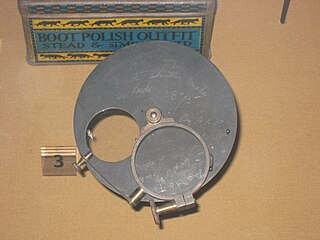
In photography, a shutter is a device that allows light to pass for a determined period, exposing photographic film or a photosensitive digital sensor to light in order to capture a permanent image of a scene. A shutter can also be used to allow pulses of light to pass outwards, as seen in a movie projector or a signal lamp. A shutter of variable speed is used to control exposure time of the film. The shutter is constructed so that it automatically closes after a certain required time interval. The speed of the shutter is controlled by a ring outside the camera, on which various timings are marked.
The photograph above shows the external flash connection socket in the upper right corner. The red lever selects among M, F, and X flash synchronizations. The shutter button is barely visible over the letter "h" of "Ricoh." The two large knobs are designed to let the user's two index fingers rapidly focus the camera while following basketball players or other rapidly moving subjects. The wired mount for an external flash unit is shown in the center of the top view of the camera. The rapid film advance lever shown in the bottom view pivots on its right end and is pulled by the extension (shown folded out of the way) near the lens barrel. The bottom view also shows a reminder ring for noting the speed of the film currently in use.
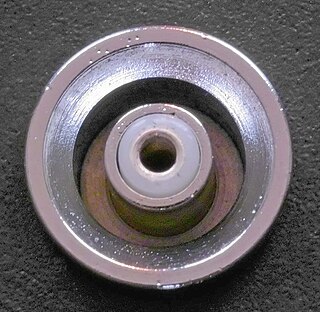
In a camera, flash synchronization is defined as synchronizing the firing of a photographic flash with the opening of the shutter admitting light to photographic film or electronic image sensor. It is often shortened to flash sync or flash synch.
The design of photographic lenses for use in still or cine cameras is intended to produce a lens that yields the most acceptable rendition of the subject being photographed within a range of constraints that include cost, weight and materials. For many other optical devices such as telescopes, microscopes and theodolites where the visual image is observed but often not recorded the design can often be significantly simpler than is the case in a camera where every image is captured on film or image sensor and can be subject to detailed scrutiny at a later stage. Photographic lenses also include those used in enlargers and projectors.

Film speed is the measure of a photographic film's sensitivity to light, determined by sensitometry and measured on various numerical scales, the most recent being the ISO system. A closely related ISO system is used to describe the relationship between exposure and output image lightness in digital cameras.
The Riken Ricomat lens had a focal length of 4.5 cm. The Seikosha shutter had provision for "m," "x," and "l" synchronization.
The rings controlling the effective lens diameter (from f/2.8 to f/22) and the shutter speed are mechanically linked so that once one combination has been matched to the ambient lighting conditions, a faster shutter speed can be selected and a larger effective lens diameter will automatically be set when possible. For instance, one might start with a setting of f/11 and 1/250 second, but decide that the moving target demanded the higher shutter speed of 1/500. Simply setting that shutter speed without changing the effective lens aperture would result in an underexposure, but the Ricoh 500 will automatically change the aperture setting to f/8.
- Top view
- Bottom view








